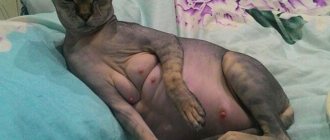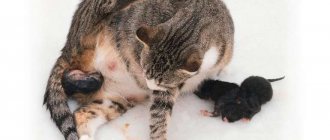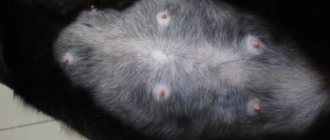Pregnancy and the subsequent birth of kittens is an extremely important period in the life of both the cat itself and its owners. Understanding the essence of the processes that occur in the animal’s body is very important - knowing about some of the nuances, you can help your pet give birth normally. In addition, the owner will know exactly when it is time to call a veterinarian for help. In particular, it is very important to know what the normal length of labor is for cats.
In all cases where your pet is experiencing visible difficulties giving birth to kittens, it never hurts to immediately call a veterinarian.
Remember that severe dystonia, accompanied by weak or absent uterine contractions, can lead to the death of not only the entire litter, but also the mother herself. Before giving birth, immediately make an appointment with your veterinarian, or always keep the phone numbers of 24-hour veterinary clinics at hand!
Brief information about a normal pregnancy
Many breeders sincerely assume that pregnancy should be considered the period from mating to the birth of kittens, but this is not entirely true. In fact, pregnancy should be considered the interval from conception (which can occur several days after mating) until the birth of the offspring . It is believed that the normal average gestation period for cats is approximately 63 days (i.e., about two months).
Please note that identifying the exact time of conception can be very difficult. We have already written above that it can occur several days after mating (this happens because the cat’s sperm remains viable in the genital tract for some time). Therefore, it is believed that from mating to the birth of kittens can take from 58 to 70 days. It is for this reason that it is recommended to show a pregnant pet to a veterinarian: an experienced specialist in a well-equipped clinic will be able to accurately determine the gestational age.
The older the cat, the less likely it is that she will be able to become pregnant at the first contact with the cat. To know for sure whether your pet is pregnant, you need to take her to a veterinary clinic that practices ultrasound pregnancy diagnosis.
Childbirth in a cat: complications
Below are potential complications that may require veterinary attention.
- The afterbirth does not come out for a long time.
- Increased temperature, fever.
- The next kitten is not born for more than two hours.
- The first stage of labor lasts more than a day.
- The appearance of a strong odor from the vagina; brownish-red discharge.
It is also very important to monitor your cat's gestational age. If it lasts more than 70 days, then an examination by a veterinarian is necessary.
Proper preparation for childbirth
The closer the expected delivery date approaches, the more restless and “cranky” your cat may become. She constantly runs around the house, rushing about, looking everywhere for a place where she can safely give birth. To help your pet, prepare a suitable box or basket in advance . You need to accustom the animal to a new place in advance. If you neglect this simple rule, your cat may well give birth right on your bed.
Some experienced breeders believe that the ideal “container” for the birth of kittens is a small playpen covered with newspapers or paper towels. How can I make sure the box dimensions are correct? It's simple - if the cat can stretch out to its full length in it, then everything is in order - there is enough space for both the mother herself and her entire litter.
The characteristics of the room where you plan to place the birthing basket or box also make a huge difference. If possible, try to choose a quiet and secluded area.
We advise you to avoid even the slightest drafts!!! In small kittens, in the first weeks of their life, the body’s thermoregulation system practically does not function, so babies can freeze to death from the most “innocent” draft.
We also advise you to stock up on towels or clean, dry rags in advance, which will come in handy if you need to dry newborn kittens. In addition, even if you have prepared a basket or box for the birth of kittens, always keep an eye on the cat: these animals are surprisingly principled and independent. If you notice that your pet is constantly sneaking under the bathroom or purposefully climbing into the closet, she almost certainly decided to give birth there. And further. It often happens to inexperienced breeders that by the time the owners notice “oddities” in the behavior of their pet, it turns out that she has already given birth a long time ago. So be careful!
We strongly recommend that you take your cat to the veterinarian within 50-55 days. A specialist will examine the animal and draw conclusions about its health.
In addition, an ultrasound examination is indicated: after it, the owner will know exactly how many kittens should be born. Finally, with the help of ultrasound analysis, the veterinarian can find out in advance about malpresentation and congenital anomalies of the fetuses. This is very important, since with many pathologies of this type, natural and first births are impossible in principle; a caesarean section or even sterilization of the cat is recommended. Finally, you will be prepared for possible problems ahead of time, and therefore will not panic when they arise (probably).
How can you find out exactly when your pet decided to give birth? At home, the simplest and most accurate diagnostic technique is to constantly measure the cat’s body temperature. Approximately one day before the onset of labor, many animals experience a significant decrease in its indicators. Thus, a cat’s normal body temperature ranges from 38.5 to 39.5° Celsius. Immediately before birth (literally a couple of hours before it) it can drop to 37.3° and even lower.
Signs that a cat is giving birth
The average gestation period for a cat is 62 to 65 days. On average they have four kittens. They may give birth several times a year, but are usually more fertile during the lighter months. During pregnancy, it is recommended to take a cat to the veterinarian for various reasons. Your veterinarian will help prevent complications, set an approximate due date, and promote a healthy pregnancy.
Changing a cat's diet during pregnancy is necessary so that they can better adapt to their body's new needs. We should note that their total food intake increases as pregnancy progresses, up to a few days before delivery. At this stage, the amount of food they eat will decrease or they may stop eating altogether.
© shutterstock
The approximate time of birth is related to changes in the cat's body temperature. By measuring it, the veterinarian can have an idea of the likely date of birth. There are other signs that a cat may give birth, such as preparing a nesting site. Here the cat is looking for a secluded and safe place to give birth and begin raising kittens. We can help by making the bed with soft materials and placing it in a warm place away from drafts and other possible obstacles. However, they can choose their own place and you should not force them to go somewhere they don't want to go. Their safety comes first.
Even before a cat gives birth, we may notice some symptoms of anxiety. They may scratch the ground, roll over, constantly get up and down, etc. We will also notice that their overall activity will decrease and they will spend more time lying down. Now that we know how to have a clear idea of when a cat will go into labor, we can discuss the actual event in more detail.
Childbirth: how long should it last in theory and in practice
We are interested in the first stages of childbirth, at the moment of which the offspring are born. Immediately after the stage accompanied by a decrease in general body temperature, the main stage of the birth process begins. During this period, the cat begins to become very worried and nervous (this is especially true for primiparous animals).
You may notice shortness of breath, a sudden increase in your pet's activity, or a refusal to eat. In rare cases, vomiting is observed (but during normal labor it is quite rare). The cat also exhibits "nesting" behavior. Once again, show your pet the box or basket in which she should give birth. Talk to the animal, stroke it, calming it down. Sometimes placing some old clothes in the basket, saturated with the owner's scent, helps. This “aromatherapy” calms many cats, as a result of which the pet no longer tries to escape and give birth on your bed.
So, the first stage normally lasts from 6 to 12 hours . During this period, the cervix should fully dilate and relax. In cases where, after 24 hours, no signs of the onset of labor appear, we strongly advise you to seek help from a veterinarian.
Main stage of labor
It is believed that at the second stage of labor, the first amniotic sac should already be visible in the animal’s genital tract. Simply put, this is the “active” period when kittens begin to be born. In this case, intense muscle contractions are already clearly visible. The cat no longer runs, she lies down, sometimes pushing hard. As a rule, this action does not take place in complete silence: the animal will meow and also attract the owner’s attention in other ways. If we draw analogies, then at this moment (especially if the cat does this for the first time), the pet seems to be experiencing an attack of severe constipation.
Remember that the first kitten should be born within an hour or two of the start of contractions. If no kitten has been born within two hours of the onset of strong contractions, we strongly advise you to contact your veterinarian!
It should be taken into account that after the birth of at least one baby, the cat can “relax”. During this period, the animal licks existing kittens, rests, and drinks water. Normally, this stage can last up to one hour (in primiparous cats), but usually the pet needs no more than half an hour to rest. After this, the period of active contractions normally begins again.
If you suspect that your pet may still have kittens in her belly, but more than four hours have passed since the last baby was born and there are still no new contractions, be sure to contact your veterinarian. Again, not all cats have resting phases. More mature and physically strong animals are able to give birth to an entire litter within a few minutes.
How does the first birth go?
A cat giving birth for the first time will behave restlessly. She does not understand what is happening, she may even be scared of her newborn offspring. Most often, pets give birth early in the morning or during the day. If the owner carefully monitors the animal, he will not miss the time of birth.
In three to four days, colostrum appears, and within a day the genitals will begin to enlarge. Pink or brown discharge may appear. Also, on the eve of birth, the pet’s behavior changes. To help her, you must first prepare the place for birth in advance so that she can get used to the new house. Place a bowl of water and food nearby. It is advisable that the tray also be placed closer (but at a distance from food and water). A week before the expected due date, it is advisable to take the animal to the veterinarian.
There is no need to be near the box all the time. After the birth of her first baby, mom will be busy. But it’s better not to go far, as in the process she may need human help.
It is advisable to have bowls of food and water near the cat.
How to properly feed a cat that has given birth?
As soon as you find out that your pet is pregnant, it is extremely important to provide her with the highest quality feeding and housing conditions. It is highly advisable that before the planned mating, the cat has already received all the vaccinations it needs.
During pregnancy, vaccination is strictly prohibited. In addition, make sure that your pet does not have parasites.
To do this, you need to provide a sample of the animal's stool to a veterinary clinic. Many types of parasites are microscopic in size, and therefore you cannot see them with the naked eye.
Remember that from about the 20th day of pregnancy, the cat's need for nutrients gradually increases. Immediately after birth, nothing changes, since the pet’s body requires resources to restore itself and feed the offspring. We highly recommend avoiding dry food: canned diets specifically designed for feeding pregnant and lactating cats are ideal. They should be given until the kittens are completely weaned.
If there are no appropriate recommendations from a veterinarian, do not give your animal any vitamins!
Remember that an excess of them is many times more dangerous than a lack. In addition, it has been repeatedly proven that excessive amounts of vitamins contribute to the development of anatomical pathologies in the structure of kittens, which is why subsequent births will either be delayed or even end in the death of the mother herself.
How many kittens can a pet produce?
In addition to the nuances regarding pregnancy and childbirth, owners are interested in the question of how many kittens a cat gives birth to for the first time and what number of newborn pets is considered normal.
As a rule, females give birth to one to three kittens for the first time.
In the future, the number of kittens may change. An owner who is interested in how many kittens a cat can give birth to maximum can familiarize themselves with the official data. Thus, the maximum number of newborn kittens was brought by a Burmese cat named Antigone. She gave birth to 15 live kittens and 4 stillborn babies. On average, mature cats bear 6-8 kittens.
When is it necessary to call a veterinarian immediately?
You should contact your veterinarian if the process of giving birth to kittens differs in any way from the scenario we described above.
It is especially important to call a veterinarian in the following cases::
- Pregnancy lasts longer than 66 days.
- The mother's temperature has dropped to 37° Celsius and lasts for a day or more (the animal becomes very lethargic and apathetic).
- There is a partial or complete refusal of food, becomes depressed, weak, and does not respond to what is happening around.
- The cat's labor lasts more than a day, but without any particular results.
- Ten or more minutes have passed since the moment the amniotic sac burst, but contractions of the uterus and birth canal cannot push the emerging kitten out.
- Powerful contractions continue for more than an hour (the cat is literally “twisted”), but nothing happens.
- The cat's figure remains pear-shaped, but more than four hours have passed since the last kitten appeared. If your pet seems anxious and nervous, it is possible that there are still kittens in her uterus.
- If your vagina discharges a strange-looking or foul-smelling discharge.
- You counted fewer afterbirths than there were kittens. Please note that in cats, retained placenta is a severe pathology, very often leading to the death of the animal.
- The kittens seem pathologically weakened and cannot independently reach their mother’s nipples.
- The mammary glands of a cat that has not yet given birth are hard and painful to the touch. This sign may indicate acute mastitis. If kittens drink such milk, they will probably die.
- The kittens do not sleep, constantly crawl away from their mother and meow. This sign often indicates that the cat does not have milk (or there is too little milk for the entire litter). This often happens in the case of excessively numerous litters.
- Kittens have bloated and swollen tummies: most likely, something is wrong with their mother’s milk.
- The temperature of a cat who has given birth remains at 39.6° Celsius for 24 hours or more after birth.
The average duration of labor is about 12 hours . Deviations from this norm are quite acceptable, but still do not forget to take into account the condition of your cat.
Signs of the onset of labor
It can be quite difficult for an inexperienced owner to understand that a cat is going into labor. It should be especially taken into account that contractions can be false. In the last days of pregnancy, the cat's behavior will change, which will be a signal to the owner about the upcoming event. Clear signs of the onset of labor are:
- enlargement and redness of the mammary glands;
- swelling of the genitals;
- the stomach drops, it becomes pear-shaped;
- intensive licking of the genitals (there should be no discharge);
- frequent urination;
- loss of appetite;
- lethargic behavior, excessive attachment to the owner.
When the water breaks, the cat will lick itself intensively.
Immediately a few hours before giving birth, the cat may become restless, meow loudly, and cannot find a place for itself. She also begins to arch her back as if she is having contractions. Such contractions of the uterus are not contractions as such. However, they become their harbingers. If your cat exhibits this behavior, you should expect her to give birth within a relatively short period of time.
False contractions are often observed several days and even weeks before the expected onset of labor. In this case, it is necessary to carefully monitor the behavior of the animal. If false contractions cause your pet significant discomfort, there is discharge from the genital tract (especially with an unpleasant odor), or she becomes too lethargic and completely refuses to eat or drink, you need to show her to a veterinarian.











